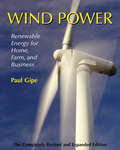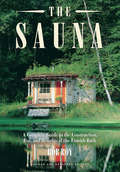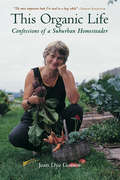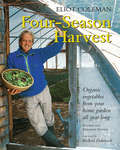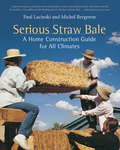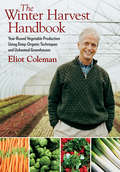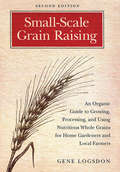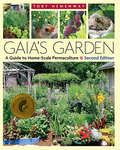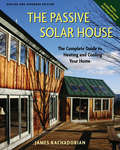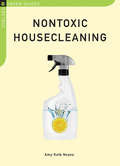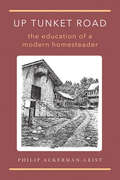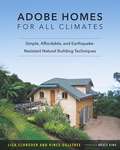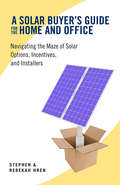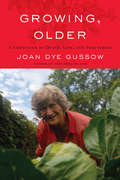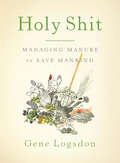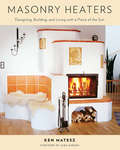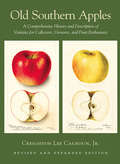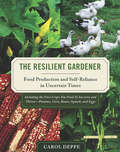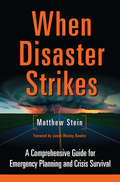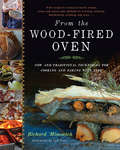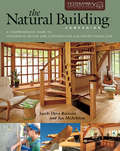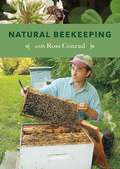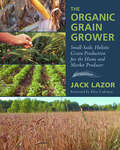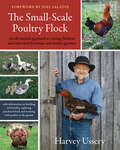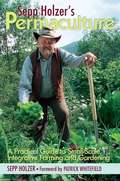- Table View
- List View
Wind Power: Renewable Energy for Home, Farm, and Business, 2nd Edition
by Paul GipeIn the wake of mass blackouts and energy crises, wind power remains a largely untapped resource of renewable energy. It is a booming worldwide industry whose technology, under the collective wing of aficionados like author Paul Gipe, is coming of age. Wind Power guides us through the emergent, sometimes daunting discourse on wind technology, giving frank explanations of how to use wind technology wisely and sound advice on how to avoid common mistakes. Since the mid-1970s, Paul Gipe has played a part in nearly every aspect of wind energy’s development—from installing small turbines to promoting wind energy worldwide. As an American proponent of renewable energy, Gipe has earned the acclaim and respect of European energy specialists for years, but his arguments have often fallen on deaf ears at home. Today, the topic of wind power is cropping up everywhere from the beaches of Cape Cod to the Oregon-Washington border, and one wind turbine is capable of producing enough electricity per year to run 200 average American households. Now, Paul Gipe is back to shed light on this increasingly important energy source with a revised edition of Wind Power. Over the course of his career, Paul Gipe has been a proponent, participant, observer, and critic of the wind industry. His experience with wind has given rise to two previous books on the subject, Wind Energy Basics and Wind Power for Home and Business, which have sold over 50,000 copies. Wind Power for Home and Business has become a staple for both homeowners and professionals interested in the subject, and now, with energy prices soaring, interest in wind power is hitting an all-time high. With chapters on output and economics, Wind Power discloses how much you can expect from each method of wind technology, both in terms of energy and financial savings. The book’s updated models, graphics, and weighty appendixes make it an invaluable reference for everyone interested in the emerging trend of wind power and renewable energy. Executive Director of the American Wind Energy Association Randall Swisher has said, "In the last two decades, no one has done more that Paul Gipe to bring wind energy to the public’s attention."
The Sauna: A Complete Guide to the Construction, Use, and Benefits of the Finnish Bath, 2nd Edition (Slow Food City Guides)
by Robert L. RoyWith a history going back at least one thousand years, the sauna is ready for a new generation of enthusiasts seeking health, pleasure, and peace of mind, and Rob Roy is ready to recruit! "If the sauna is just a bath, then Buckingham Palace is just a house." So writes sauna expert and intrepid do-it-yourselfer Roy in this new, updated version of The Sauna. This completely revised and expanded edition of The Sauna contains everything you ever wanted to know about the famous "Finnish bath." In this inviting book, Roy shares his infectious enthusiasm for the sauna and provides a complete, detailed guide to sauna building, along with resources for equipment and supplies. The Sauna is replete with history, tradition, health benefits, instructions for proper use and maintenance, as well as step-by-step instructions for building a variety of cordwood masonry saunas and, new to this edition, conventionally wood-framed saunas. The beautiful color photographs, also new to this edition, will inspire you to create your own sauna haven.
This Organic Life: Confessions of a Suburban Homesteader (Polyface Titles Ser.)
by Joan Dye GussowJoan Dye Gussow is an extraordinarily ordinary woman. She lives in a home not unlike the average home in a neighborhood that is, more or less, typically suburban. What sets her apart from the rest of us is that she thinks more deeply--and in more eloquent detail--about food. In sharing her ponderings, she sets a delightful example for those of us who seek the healthiest, most pleasurable lifestyle within an environment determined to propel us in the opposite direction. Joan is a suburbanite with a green thumb, with a feisty, defiant spirit and a relentlessly positive outlook. At the heart of This Organic Life is the premise that locally grown food eaten in season makes sense economically, ecologically, and gastronomically. Transporting produce to New York from California--not to mention Central and South America, Australia, or Europe--consumes more energy in transit than it yields in calories. (It costs 435 fossil fuel calories to fly a 5-calorie strawberry from California to New York.) Add in the deleterious effects of agribusiness, such as the endless cycle of pesticide, herbicide, and chemical fertilizers; the loss of topsoil from erosion of over-tilled croplands; depleted aquifers and soil salinization from over-irrigation; and the arguments in favor of "this organic life" become overwhelmingly convincing. Joan's story is funny and fiery as she points out the absurdities we have unthinkingly come to accept. You won't find an electric can opener in this woman's house. In fact, you probably won't find many cans, as Joan has discovered ways to nourish herself, literally and spiritually, from her own backyard. If you are looking for a tale of courage and independence in a setting that is entirely familiar, read her story.
Four-Season Harvest: Organic Vegetables from Your Home Garden All Year Long, 2nd Edition
by Eliot Coleman Kathy Bray Barbara DamroschIf you love the joys of eating home-garden vegetables but always thought those joys had to stop at the end of summer, this book is for you. Eliot Coleman introduces the surprising fact that most of the United States has more winter sunshine than the south of France. He shows how North American gardeners can successfully use that sun to raise a wide variety of traditional winter vegetables in backyard cold frames and plastic covered tunnel greenhouses without supplementary heat. Coleman expands upon his own experiences with new ideas learned on a winter-vegetable pilgrimage across the ocean to the acknowledged kingdom of vegetable cuisine, the southern part of France, which lies on the 44th parallel, the same latitude as his farm in Maine. This story of sunshine, weather patterns, old limitations and expectations, and new realities is delightfully innovative in the best gardening tradition. Four-Season Harvest will have you feasting on fresh produce from your garden all through the winter. To learn more about the possibility of a four-season farm, please visit Coleman's website www.fourseasonfarm.com.
Serious Straw Bale: A Home Construction Guide for All Climates
by Paul Lacinski Michel BergeronIn 1994, when Chelsea Green published The Straw Bale House, the response from many people was a loud, "Huh?!" Those days are gone. With more than 100,000 copies sold, and straw bale projects underway in most regions of North America, we've entered a new era. Even building-code officials and insurance companies now look favorably upon straw bale buildings, with their extraordinary energy efficiency and wise use of agricultural waste for construction materials. Bergeron and Lacinski's new book Serious Straw Bale is the first to look carefully at the specific design considerations critical to success with a straw bale building in more extreme climates-where seasonal changes in temperature, precipitation, and humidity create special stresses that builders must understand and address. The authors draw upon years of experience with natural materials and experimental techniques, and present a compelling rationale for building with straw-one of nature's most resilient, available, and affordable byproducts. For skeptics and true believers, this book will prove to be the latest word. Thorough explanations of how moisture and temperature affect buildings in seasonal climates, with descriptions of the unique capacities of straw and other natural materials to provide warmth, quiet, and comfort year-round. Comprehensive comparison of the two main approaches to straw bale construction: "Nebraska-style," where bales bear the weight of the roof, and framed structures, where bales provide insulation. Detailed advice-including many well-considered cautions-for contractors, owner-builders, and designers, following each stage of a bale-building process. This is a second-generation straw bale book, for those seeking serious information to meet serious challenges while adventuring in the most fun form of construction to come along in several centuries.
The Winter Harvest Handbook: Year Round Vegetable Production Using Deep-Organic Techniques and Unheated Greenhouses
by Eliot Coleman Barbara DamroschChoosing locally grown organic food is a sustainable living trend that’s taken hold throughout North America. Celebrated farming expert Eliot Coleman helped start this movement with The New Organic Grower published 20 years ago. He continues to lead the way, pushing the limits of the harvest season while working his world-renowned organic farm in Harborside, Maine. Now, with his long-awaited new book, The Winter Harvest Handbook, anyone can have access to his hard-won experience. Gardeners and farmers can use the innovative, highly successful methods Coleman describes in this comprehensive handbook to raise crops throughout the coldest of winters. Building on the techniques that hundreds of thousands of farmers and gardeners adopted from The New Organic Grower and Four-Season Harvest, this new book focuses on growing produce of unparalleled freshness and quality in customized unheated or, in some cases, minimally heated, movable plastic greenhouses. Coleman offers clear, concise details on greenhouse construction and maintenance, planting schedules, crop management, harvesting practices, and even marketing methods in this complete, meticulous, and illustrated guide. Readers have access to all the techniques that have proven to produce higher-quality crops on Coleman’s own farm. His painstaking research and experimentation with more than 30 different crops will be valuable to small farmers, homesteaders, and experienced home gardeners who seek to expand their production seasons. A passionate advocate for the revival of small-scale sustainable farming, Coleman provides a practical model for supplying fresh, locally grown produce during the winter season, even in climates where conventional wisdom says it “just can’t be done.”
Small-Scale Grain Raising: An Organic Guide to Growing, Processing, and Using Nutritious Whole Grains for Home Gardeners and Local Farmers, 2nd Edition
by Gene Logsdon Jerry O'BrienFirst published in 1977, this book—from one of America’s most famous and prolific agricultural writers—became an almost instant classic among homestead gardeners and small farmers. Now fully updated and available once more, Small-Scale Grain Raising offers a entirely new generation of readers the best introduction to a wide range of both common and lesser-known specialty grains and related field crops, from corn, wheat, and rye to buckwheat, millet, rice, spelt, flax, and even beans and sunflowers. More and more Americans are seeking out locally grown foods, yet one of the real stumbling blocks to their efforts has been finding local sources for grains, which are grown mainly on large, distant corporate farms. At the same time, commodity prices for grains—and the products made from them—have skyrocketed due to rising energy costs and increased demand. In this book, Gene Logsdon proves that anyone who has access to a large garden or small farm can (and should) think outside the agribusiness box and learn to grow healthy whole grains or beans—the base of our culinary food pyramid—alongside their fruits and vegetables. Starting from the simple but revolutionary concept of the garden “pancake patch,” Logsdon opens up our eyes to a whole world of plants that we wrongly assume only the agricultural “big boys” can grow. He succinctly covers all the basics, from planting and dealing with pests, weeds, and diseases to harvesting, processing, storing, and using whole grains. There are even a few recipes sprinkled throughout, along with more than a little wit and wisdom. Never has there been a better time, or a more receptive audience, for this book. Localvores, serious home gardeners, CSA farmers, and whole-foods advocates—in fact, all people who value fresh, high-quality foods—will find a field full of information and ideas in this once and future classic.
Gaia's Garden: A Guide to Home-Scale Permaculture, 2nd Edition
by Toby HemenwayThe first edition of Gaia’s Garden sparked the imagination of America’s home gardeners, introducing permaculture’s central message: Working with Nature, not against her, results in more beautiful, abundant, and forgiving gardens. This extensively revised and expanded second edition broadens the reach and depth of the permaculture approach for urban and suburban growers. Many people mistakenly think that ecological gardening—which involves growing a wide range of edible and other useful plants—can take place only on a large, multiacre scale. As Hemenway demonstrates, it’s fun and easy to create a “backyard ecosystem” by assembling communities of plants that can work cooperatively and perform a variety of functions, including: Building and maintaining soil fertility and structure Catching and conserving water in the landscape Providing habitat for beneficial insects, birds, and animals Growing an edible “forest” that yields seasonal fruits, nuts, and other foods This revised and updated edition also features a new chapter on urban permaculture, designed especially for people in cities and suburbs who have very limited growing space. Whatever size yard or garden you have to work with, you can apply basic permaculture principles to make it more diverse, more natural, more productive, and more beautiful. Best of all, once it’s established, an ecological garden will reduce or eliminate most of the backbreaking work that’s needed to maintain the typical lawn and garden.
The Passive Solar House: Using Solar Design to Cool and Heat Your Home, 2nd Edition
by James KachadorianRevised and Expanded Edition - Includes CD-ROM with Custom Design Software For the past ten years The Passive Solar House has offered proven techniques for building homes that heat and cool themselves, using readily available materials and methods familiar to all building contractors and many do-it-yourself homeowners. True to this innovative, straightforward approach, the new edition of this best-selling guide includes CSOL passive solar design software, making it easier than ever to heat your home with the power of the sun. Since The Passive Solar House was first published, passive solar construction expert James Kachadorian has perfected user-friendly, Windows-compatible software to supplement the design process explained in the book by allowing homeowners/designers to enter the specifications of their design and see how changing a variable will affect its energy efficiency. This is the building book for a world of climbing energy costs. Applicable to diverse regions, climates, budgets, and styles of architecture, Kachadorian's techniques translate the essentials of timeless solar design into practical wisdom for today's solar builders. Profiles of successful passive solar design, construction, and retrofit projects from readers of the first edition provide inspiration to first-time homebuilders and renovators alike.
Nontoxic Housecleaning (Chelsea Green Guides)
by Amy Kolb NoyesWhen it comes to cleaning products, society often values convenience over personal and planetary health, thanks to decades of advertising propaganda from the chemical companies that market overpriced and dangerous concoctions. But awareness is changing: Not only are homemade and nontoxic cleaners strong enough for the toughest grunge, they are often as convenient as their commercial counterparts. Nontoxic Housecleaning—the latest in the Chelsea Green Guide series—provides a way for people to improve their immediate environment every day. Pregnant women, parents of young children, pet owners, people with health concerns, and those who simply care about a healthy environment—and a sensible budget—can all benefit from the recipes and tips in this guide. Included are tips for: The basic ingredients: what they are, and why they work. Specific techniques for each room and cleaning need in the house. Detailed recipes for homemade cleaners, including floor polishes, all-purpose cleanser, disinfecting cleanser, window cleaner, oven cleaner, furniture polish, mold- and mildew-killing cleansers, bathroom scrub, deodorizers, stain removers, laundry boosters and starch, metal polishes, scouring powder, and more.
Up Tunket Road: The Education of a Modern Homesteader
by Philip Ackerman-Leist Erin Ackerman-LeistEver since Thoreau's Walden, the image of the American homesteader has been of someone getting away from civilization, of forging an independent life in the country. Yet if this were ever true, what is the nature and reality of homesteading in the media-saturated, hyper-connected 21st century? For seven years Philip Ackerman-Leist and his wife, Erin, lived without electricity or running water in an old cabin in the beautiful but remote hills of western New England. Slowly forging their own farm and homestead, they took inspiration from their experiences among the mountain farmers of the Tirolean Alps and were guided by their Vermont neighbors, who taught them about what it truly means to live sustainably in the postmodern homestead--not only to survive, but to thrive in a fragmented landscape and a fractured economy. Up Tunket Road is the inspiring true story of a young couple who embraced the joys of simple living while also acknowledging its frustrations and complexities. Ackerman-Leist writes with humor about the inevitable foibles of setting up life off the grid--from hauling frozen laundry uphill to getting locked in the henhouse by their ox. But he also weaves an instructive narrative that contemplates the future of simple living. His is not a how-to guide, but something much richer and more important--a tale of discovery that will resonate with readers who yearn for a better, more meaningful life, whether they live in the city, country, or somewhere in between.
Adobe Homes for All Climates: Simple, Affordable, and Earthquake-Resistant Natural Building Techniques
by Lisa Schroder Vince OgletreeThe lay-up of adobe bricks is an easy, forgiving way to achieve a solid masonry-wall system. Contrary to stereotypes, adobe is perfectly adaptable for use in cold, wet climates as well as hot and dry ones, and for areas prone to earthquakes. With its efficient use of energy, natural resources for construction, and minimal effort for long-term maintenance, it’s clear that the humble adobe brick is an ideal option for constructing eco-friendly structures throughout the world. The book is ideal both for first-time do-it-yourselfers and for experienced adobe builders seeking to improve their craft. Drawing on the experience of more than fifty major adobe projects since 1993, Adobe Homes for All Climates describes Adobe Building Systems’ patented reinforcement and scaffolding systems, showing readers how to construct adobe homes more easily and safely, and with superior strength, durability, structural integrity, and aesthetic appeal, as compared to earthen homes of the past. All aspects of adobe construction are covered, including making and laying adobe bricks, installing lintels and arches, conduits and pipes, doors and windows, top plates and bondbeams, ideal wall dimensions, adobe finishes, and other adobe construction components, such as the inexpensive use of scaffolding. These methods will produce a premium product that will meet and often exceed inspection standards. Equipped with this manual, you will be able to obtain a building permit, make adobe bricks swiftly, and confidently lay them up. You will be able to beautifully finish your adobe walls with earth plasters creating stunning colors and outstanding light effects and create a beautiful, energy-efficient home that will last for generations to come.
A Solar Buyer's Guide for the Home and Office: Navigating the Maze of Solar Options, Incentives, and Installers
by Stephen Hren Rebekah HrenSolar power, once a fringe effort limited to DIY enthusiasts, is now fast becoming mainstream. Many home and business owners are curious about solar electric and solar thermal systems, and wonder how to go about getting a clean energy generation system of their own. The vast majority will hire a professional installer to do the job. But what should they be asking of these installers? What system makes the most sense for their home or office: solar electric, solar hot water, solar heating, or some combination of these? A Solar Buyer's Guide for the Home and Office explains the options so that property owners can make the right choices both for their energy needs and their financial security. Understanding how solar power systems work will enable readers to be informed customers when dealing with professional installers-the book also provides advice on how to select a qualified installer and understand the expanding variety of tax credits and other incentives that are popping up around the country. The market for solar systems has been growing at an exponential rate and strong tax credits ensure continued growth even in a sluggish economy. Many of those who would like to catch this undeniable wave of the future are held back by widespread confusion. A Solar Buyer's Guide for the Home and Office clears the air, allowing property owners to move forward with confidence to make their homes and offices more comfortable, environmentally sound, and secure against wild swings in energy prices.
Growing, Older: A Chronicle of Death, Life, and Vegetables
by Joan Dye GussowMichael Pollan calls her one of his food heroes. Barbara Kingsolver credits her with shaping the history and politics of food in the United States. And countless others who have vied for a food revolution, pushed organics, and reawakened Americans to growing their own food and eating locally consider her both teacher and muse.Joan Gussow has influenced thousands through her books, This Organic Life and The Feeding Web, her lectures, and the simple fact that she lives what she preaches. Now in her eighties, she stops once more to pass along some wisdom-surprising, inspiring, and controversial-via the pen. Gussow's memoir Growing, Older begins when she loses her husband of 40 years to cancer and, two weeks later, finds herself skipping down the street-much to her alarm. Why wasn't she grieving in all the normal ways? With humor and wit, she explains how she stopped worrying about why she was smiling and went on worrying, instead, and as she always has, about the possibility that the world around her was headed off a cliff. But hers is not a tale, or message, of gloom. Rather it is an affirmation of a life's work-and work in general. Lacking a partner's assistance, Gussow continued the hard labor of growing her own year-round diet. She dealt single-handedly with a rising tidal river that regularly drowned her garden, with muskrat interlopers, broken appliances, bodily decay, and river trash-all the while bucking popular notions of how "an elderly widowed woman" ought to behave. Scattered throughout are urgent suggestions about what growing older on a changing planet will call on all of us to do: learn self-reliance and self-restraint, yield graciously if not always happily to necessity, and-since there is no other choice-come to terms with the insistencies of the natural world. Gussow delivers another literary gem-one that women curious about aging, gardeners curious about contending with increasingly intense weather, or environmentalists curious about the future will embrace.
Holy Sh*t: Managing Manure to Save Mankind
by Gene Logsdon Brooke BudnerIn his insightful new book, Holy Sh*t: Managing Manure to Save Mankind, contrary farmer Gene Logsdon provides the inside story of manure-our greatest, yet most misunderstood, natural resource. He begins by lamenting a modern society that not only throws away both animal and human manure-worth billions of dollars in fertilizer value-but that spends a staggering amount of money to do so. This wastefulness makes even less sense as the supply of mined or chemically synthesized fertilizers dwindles and their cost skyrockets. In fact, he argues, if we do not learn how to turn our manures into fertilizer to keep food production in line with increasing population, our civilization, like so many that went before it, will inevitably decline. With his trademark humor, his years of experience writing about both farming and waste management, and his uncanny eye for the small but important details, Logsdon artfully describes how to manage farm manure, pet manure and human manure to make fertilizer and humus. He covers the field, so to speak, discussing topics like: How to select the right pitchfork for the job and use it correctly How to operate a small manure spreader How to build a barn manure pack with farm animal manure How to compost cat and dog waste How to recycle toilet water for irrigation purposes, and How to get rid ourselves of our irrational paranoia about feces and urine. Gene Logsdon does not mince words. This fresh, fascinating and entertaining look at an earthy, but absolutely crucial subject, is a small gem and is destined to become a classic of our agricultural literature.
Masonry Heaters: Designing, Building, and Living with a Piece of the Sun
by Ken Matesz Albie BardenMasonry Heaters is a complete guide to designing and living with one of the oldest, and yet one of the newest, heating devices. A masonry heater’s design, placement in the home, and luxurious radiant heat redefine the hearth for the modern era, turning it into a piece of the sun right inside the home. Like the feeling one gets from the sun on a spring day, the environment around a masonry heater feels fresh. The radiant heat feels better on the skin. It warms the home both gently and efficiently. In fact, the value of a masonry heater lies in its durability, quality, serviceability, dependability, and health-supporting features. And it is an investment in self-sufficiency and freedom from fossil fuels. The book discusses different masonry heater designs, including variations extant in Europe, and explains the growth of their popularity in the United States beginning in the late 1970s. For the reader who may be familiar only with open fireplaces and metal woodstoves, Masonry Heaters will bring a new understanding and appreciation of massive heat storage and gentle-but-persistent radiant heat. Masonry heaters offer a unique comfort that is superior to that from convection heat from forced-air systems, and more personal than that offered by “radiant” floors. As Matesz demonstrates, the heat from the sun or from a masonry heater is genuine heat instead of just insulation against the loss of heat. Those who are looking to build, add onto, or remodel a house will find comprehensive and practical advice for designing and installing a masonry heater, including detailed discussion of materials, code considerations, and many photos and illustrations. While this is not a do-it-yourself guide for building a masonry heater, it provides facts every heater builder should know. Professional contractors will find this a useful tool to consult, and homeowners considering a new method of home heating will find all they need to know about masonry heaters within these pages.
Old Southern Apples: A Comprehensive History and Description of Varieties for Collectors, Growers, and Fruit Enthusiasts, 2nd Edition
by Creighton Lee CalhounA book that became an instant classic when it first appeared in 1995, Old Southern Apples is an indispensable reference for fruit lovers everywhere, especially those who live in the southern United States. Out of print for several years, this newly revised and expanded edition now features descriptions of some 1,800 apple varieties that either originated in the South or were widely grown there before 1928. Author Lee Calhoun is one of the foremost figures in apple conservation in America. This masterwork reflects his knowledge and personal experience over more than thirty years, as he sought out and grew hundreds of classic apples, including both legendary varieties (like Nickajack and Magnum Bonum) and little-known ones (like Buff and Cullasaga). Representing our common orchard heritage, many of these apples are today at risk of disappearing from our national table. Illustrated with more than 120 color images of classic apples from the National Agricultural Library’s collection of watercolor paintings, Old Southern Apples is a fascinating and beautiful reference and gift book. In addition to A-to-Z descriptions of apple varieties, both extant and extinct, Calhoun provides a brief history of apple culture in the South, and includes practical information on growing apples and on their traditional uses.
The Resilient Gardener: Food Production and Self-Reliance in Uncertain Times
by Carol DeppeScientist/gardener Carol Deppe combines her passion for organic gardening with newly emerging scientific information from many fields — resilience science, climatology, climate change, ecology, anthropology, paleontology, sustainable agriculture, nutrition, health, and medicine. In the last half of The Resilient Gardener, Deppe extends and illustrates these principles with detailed information about growing and using five key crops: potatoes, corn, beans, squash, and eggs. In this book you’ll learn how to: •Garden in an era of unpredictable weather and climate change •Grow, store, and use more of your own staple crops •Garden efficiently and comfortably (even if you have a bad back) •Grow, store, and cook different varieties of potatoes and save your own potato seed •Grow the right varieties of corn to make your own gourmet-quality fast-cooking polenta, cornbread, parched corn, corn cakes, pancakes and even savory corn gravy •Make whole-grain, corn-based breads and cakes using the author’s original gluten-free recipes involving no other grains, artificial binders, or dairy products •Grow and use popbeans and other grain legumes •Grow, store, and use summer, winter, and drying squash •Keep a home laying flock of ducks or chickens; integrate them with your gardening, and grow most of their feed. The Resilient Gardener is both a conceptual and a hands-on organic gardening book, and is suitable for vegetable gardeners at all levels of experience. Resilience here is broadly conceived and encompasses a full range of problems, from personal hard times such as injuries, family crises, financial problems, health problems, and special dietary needs (gluten intolerance, food allergies, carbohydrate sensitivity, and a need for weight control) to serious regional and global disasters and climate change. It is a supremely optimistic as well as realistic book about how resilient gardeners and their vegetable gardens can flourish even in challenging times and help their communities to survive and thrive through everything that comes their way — from tomorrow through the next thousand years. Organic gardening, vegetable gardening, self-sufficiency, subsistence gardening, gluten-free living.
When Disaster Strikes: A Comprehensive Guide for Emergency Prepping and Crisis Survival
by Matthew Stein James Wesley RawlesDisasters often strike without warning and leave a trail of destruction in their wake. Yet armed with the right tools and information, survivors can fend for themselves and get through even the toughest circumstances. Matthew Stein's When Disaster Strikes provides a thorough, practical guide for how to prepare for and react in many of life's most unpredictable scenarios. In this disaster-preparedness manual, he outlines the materials you'll need-from food and water, to shelter and energy, to first-aid and survival skills-to help you safely live through the worst. When Disaster Strikes covers how to find and store food, water, and clothing, as well as the basics of installing back-up power and lights. You'll learn how to gather and sterilize water, build a fire, treat injuries in an emergency, and use alternative medical sources when conventional ones are unavailable. Stein instructs you on the smartest responses to natural disasters-such as fires, earthquakes, hurricanes and floods-how to keep warm during winter storms, even how to protect yourself from attack or other dangerous situations. With this comprehensive guide in hand, you can be sure to respond quickly, correctly, and confidently when a crisis threatens.
From the Wood-Fired Oven: New and Traditional Techniques for Cooking and Baking with Fire
by Richard Miscovich Daniel WingIn the past twenty years, interest in wood-fired ovens has increased dramatically in the United States and abroad, but most books focus on how to bake bread or pizza in an oven. From the Wood-Fired Oven offers many more techniques for home and artisan bakers—from baking bread and making pizza to recipes on how to get as much use as possible out of a single oven firing, from the first live-fire roasting to drying wood for the next fire. From the Wood-Fired Oven offers a new take on traditional techniques for professional bakers, but is simple enough to inspire any nonprofessional baking enthusiast. Leading baker and instructor Richard Miscovich wants people to use their ovens to fulfill the goal of maximum heat utilization. Readers will find methods and techniques for cooking and baking in a wood-fired oven in the order of the appropriate temperature window. What comes first—pizza, or pastry? Roasted vegetables or a braised pork loin? Clarified butter or beef jerky? In addition to an extensive section of delicious formulas for many types of bread, readers will find chapters on: • Making pizza and other live-fire flatbreads; • Roasting fish and meats; • Grilling, steaming, braising, and frying; • Baking pastry and other recipes beyond breads; • Rendering animal fats and clarifying butter; • Food dehydration and infusing oils; • And myriad other ways to use the oven's residual heat. Appendices include oven-design recommendations, a sample oven temperature log, Richard's baker's percentages, proper care of a sourdough starter, and more. . . . From the Wood Fired Oven is more than a cookbook; it reminds the reader of how a wood-fired oven (and fire, by extension) draws people together and bestows a sense of comfort and fellowship, very real human needs, especially in uncertain times. Indeed, cooking and baking from a wood-fired oven is a basic part of a resilient lifestyle, and a perfect example of valuable traditional skills being put to use in modern times.
The Natural Building Companion: A Comprehensive Guide to Integrative Design and Construction
by Jacob Deva Racusin Ace McArletonNatural buildings not only bring satisfaction to their makers and joy to their occupants, they also leave the gentlest footprint on the environment. In this complete reference to natural building philosophy, design, and technique, Jacob Deva Racusin and Ace McArleton walk builders through planning and construction, offering step-by-step instructions on: siting and site analysis choosing materials integrating basic structural considerations into a design strategies for heating/cooling efficiency and moisture management planning for acoustics developing an integrative design navigating budgeting, code compliance, and project management creating the foundation, wall system, roof, and floors selecting and making plasters and paints evaluating options for mechanical and utility systems protecting against fire and insects integrating structures within landscape, climate, and human communities ...and more Applicable to building in climates that are cold and wet, hot and dry, or somewhere in-between, The Natural Building Companion provides the tools necessary to understand basic principles of building science, including structural and thermal engineering, and hydrodynamics. This guide offers thorough, up-to-date, and advanced installation details and performance characteristics of straw-bale, straw-clay, woodchip-clay, and cellulose wall systems, as well as earthen and stone wall systems and a variety of framing, roofing, flooring, mechanical system, and finishing options. This fully-illustrated volume informs professionals making the transition from conventional building, homeowners embarking on their own construction, or green builders who want comprehensive guidance on natural-building options. A State-of-the-Art Resource for Natural Builders The Natural Building Companion is a part of The Yestermorrow Design/Build Library and includes an instructional DVD.
Natural Beekeeping: Organic Approaches to Modern Apiculture, 2nd Edition
by Ross Conrad Gary Paul NabhanToday's beekeepers face unprecedented challenges, a fact that is now front-page news with the spread of "colony collapse disorder." Newly introduced pests like varroa and tracheal mites have made chemical treatment of hives standard practice, but pest resistance is building, which in turn creates demand for new and even more toxic chemicals. In fact, there is evidence that chemical treatments are making matters worse. It's time for a new approach. Now revised and updated with new resources and including full-color photos throughout, Natural Beekeeping offers all the latest information in a book that has already proven invaluable for organic beekeepers. The new edition offers the same holistic, sensible alternative to conventional chemical practices with a program of natural hive management, but offers new sections on a wide range of subjects, including: The basics of bee biology and anatomy Urban beekeeping Identifying and working with queens Parasitic mite control Hive diseases Also, a completely new chapter on marketing provides valuable advice for anyone who intends to sell a wide range of hive products.Ross Conrad brings together the best "do no harm" strategies for keeping honeybees healthy and productive with nontoxic methods of controlling mites; eliminating American foulbrood disease without the use of antibiotics; selective breeding for naturally resistant bees; and many other detailed management techniques, which are covered in a thoughtful, matter-of-fact way. Whether you are a novice looking to get started with bees, an experienced apiculturist looking for ideas to develop an integrated pest-management approach, or someone who wants to sell honey at a premium price, this is the book you've been waiting for.
The Organic Grain Grower: Small-Scale, Holistic Grain Production for the Home and Market Producer
by Jack LazorThe ultimate guide to growing organic grains on a small and ecological scale, The Organic Grain Grower is invaluable for both home-scale and commercial producers interested in expanding their resiliency and crop diversity through growing their own grains. Longtime farmer and organic pioneer Jack Lazor covers how to grow and store wheat, barley, oats, corn, dry beans, soybeans, pulse crops, oilseeds, grasses, nutrient-dense forages, and lesser-known cereals. In addition to detailed cultivation and processing information, Lazor argues the importance of integrating grains on the organic farm (not to mention for the local-food system) for reasons of biodiversity and whole farm management. Including extensive information on: The history of grain growing and consumption in North America The twenty-first century and the birth of the local-food movement Considering your farm's scale and climate Understanding soil fertility and structure Planting your crop (including spring vs. fall cereals and preparing your soil) The growing and ripening process (reproductive, milk, hard-and-soft dough stages) The grain harvest Preparing grain for sale, storage, or end use (drying, cleaning seed, grain handling) Seed breeding and saving Machinery, infrastructure, and processing (both home-scale tools and larger farm equipment) Grinding grains for livestock rations (including how to put together a ration based on protein content) and sample rations for dairy cows, pigs, and chickens Processing grains for human consumption Additional resources and information for new grain farmers, and more... Beginners will learn how to grow enough wheat for a year's supply of bread flour for their homestead, and farmers will learn how to become part of a grain co-op, working alongside artisan bakers and mills. Never before has there been a guide to growing organic grains applicable both for the home-scale and professional farming scale. This will be a classic for decades to come and a crucial addition to any farmer's, homesteader's, gardener's, agronomist's, or seed-saver's library.
The Small-Scale Poultry Flock: An All-Natural Approach to Raising Chickens and Other Fowl for Home and Market Growers
by Harvey Ussery Joel SalatinThe most comprehensive guide to date on raising all-natural poultry for the small-scale farmer, homesteader, and professional grower. The Small-Scale Poultry Flock offers a practical and integrative model for working with chickens and other domestic fowl, based entirely on natural systems. Readers will find information on growing (and sourcing) feed on a small scale, brooding (and breeding) at home, and using poultry as insect and weed managers in the garden and orchard. Ussery's model presents an entirely sustainable system that can be adapted and utilized in a variety of scales, and will prove invaluable for beginner homesteaders, growers looking to incorporate poultry into their farm, or poultry farmers seeking to close their loop. Ussery offers extensive information on: The definition of an integrated poultry flock (imitation of natural systems, integrating patterns, and closing the circle) Everything you need to know about your basic chicken (including distinctive points about anatomy and behavior that are critical to management) Extended information on poultry health and holistic health care, with a focus on prevention Planning your flock (flock size, choosing breeds, fowl useful for egg vs. meat production, sourcing stock) How to breed and brood the flock (including breeding for genetic conservation), including the most complete guide to working with broody hens available anywhere Making and mixing your own feed (with tips on equipment, storage, basic ingredients, technique, grinding and mixing) Providing more of the flock's feed from sources grown or self-foraged on the homestead or farm, including production of live protein feeds using earthworms and soldier grubs Using poultry to increase soil fertility, control crop damaging insects, and to make compost-including systems for pasturing and for tillage of cover crops and weeds Recipes for great egg and poultry dishes (including Ussery's famous chicken stock!) And one of the best step-by-step poultry butchering guides available, complete with extensive illustrative photos. No other book on raising poultry takes an entirely whole-systems approach, or discusses producing homegrown feed and breeding in such detail. This is a truly invaluable guide that will lead farmers and homesteaders into a new world of self-reliance and enjoyment.
Sepp Holzer's Permaculture: A Practical Guide to Small-Scale, Integrative Farming and Gardening
by Sepp Holzer Patrick Whitefield Anna Sapsford-FrancisSepp Holzer farms steep mountainsides in Austria 1,500 meters above sea level. His farm is an intricate network of terraces, raised beds, ponds, waterways and tracks, well covered with productive fruit trees and other vegetation, with the farmhouse neatly nestling amongst them. This is in dramatic contrast to his neighbors' spruce monocultures.In this book, Holzer shares the skill and knowledge acquired over his lifetime. He covers every aspect of his farming methods, not just how to create a holistic system on the farm itself, but how to make a living from it. Holzer writes about everything from the overall concepts, down to the practical details.In Sepp Holzer's Permaculturereaders will learn: How he sets up a permaculture system The fruit varieties he has found best for permaculture growing How to construct terraces, ponds, and waterways How to build shelters for animals and how to work with them on the land How to cultivate edible mushrooms in the garden and on the farm and much more! Holzer offers a wealth of information for the gardener, smallholder or alternative farmer yet the book's greatest value is the attitudes it teaches. He reveals the thinking processes based on principles found in nature that create his productive systems. These can be applied anywhere.
